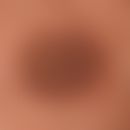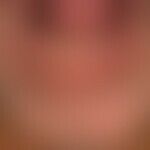Synonym(s)
DefinitionThis section has been translated automatically.
Group of chronic blistering autoimmune diseases with intraepidermal blistering of the skin and mucous membranes, characterized as follows:
- Clinically characterized by flaccid, easily injured blisters and an eminently chronic course.
- Histologically characterized by intraepidermal acantholytic blistering due to loss of cell-to-cell adhesion of keratinocytes.
- Immunohistopathologically by tissue-bound and circulating autoantibodies of the IgG (and IgA) class against surface epitopes of keratinocytes.
- The functional inhibition of desmogleins by pemphigus antibodies leads to a loss of adhesion of the keratinocytes and to intraepidermal blister formation.
ClassificationThis section has been translated automatically.
The group of pemphigus diseases can be divided into:
- Pemphigus vulgaris:
- Mucosal-dominant type
- Mucocutaneous type.
- Pemphigus vegetans:
- Pemphigus vegetans, Neumann type
- Pemphigus vegetans , Hallopeau type.
- Pemphigus foliaceus:
- Pemphigus erythematosus (Senear-Usher syndrome)
- Pemphigus foliaceus , Brazilian (endemic type/fogo selvagem)
- Pemphigus herpetiformis (rarely P. vulgaris).
- Pemphigus paraneoplastic
- Pemphigus IgA pemphigus:
- IEN type (intraepidermal neutrophilic IgA dermatosis)
- SPD type (subcorneal pustular dermatosis).
- IgG/IgA pemphigus (intercellular IgG/IgA dermatosis)
- Drug-induced pemphigus.
You might also be interested in
EtiopathogenesisThis section has been translated automatically.
Autoimmune disease with formation of circulating autoantibodies against desmosomal adhesion molecules (desmogleins - more rarely desmocollins) of the cadherin group (calcium-dependent, transmembranous adhesion molecules), which are responsible for the intercellular cohesion of the epithelia. In classic pemphigus vulgaris, the binding of autoantibodies to the extracellular domain of the desmogleins leads to dissociation of the intercellular connections(desmosomes) without major inflammatory symptoms (no involvement of inflammatory cells or proteases!) and thus to acantholysis with degeneration of the keratinocytes ( Tzanck cell). The antigens of pemphigus vulgaris and foliaceus are glycoproteins of 130 and 160 kDa. The 160 kDa antigen corresponds to desmoglein 1 and characterizes pemphigus foliaceus.
DiagnosisThis section has been translated automatically.
Differential diagnosisThis section has been translated automatically.
TherapyThis section has been translated automatically.
General therapyThis section has been translated automatically.
TablesThis section has been translated automatically.
Immunological constellations
Disease |
Autoantibodies |
Autoantigen |
|
(Mucosa type and mucocutaneous type) |
IgG |
Desmoglein 3 |
desmoglein 1 | ||
Desmocolline | ||
Plakoglobin | ||
Cholinergic receptor of keratinocytes | ||
| ||
IgG |
desmoglein 1 |
|
Plakoglobin | ||
Desmoglein 3 | ||
Desmoplakin 1 | ||
Desmoplakin 2 | ||
Cholinergic receptor of keratinocytes | ||
| ||
IgG |
Desmoglein 3 |
|
desmoglein 1 | ||
desmocollin 1 | ||
desmocollin 2 | ||
| ||
IgG |
Desmoglein 1 and 3 |
|
Desmocollin 3 | ||
| ||
IgG |
desmoglein 1 |
|
Nuclear antigens | ||
| ||
IgG |
Desmoglein 3 |
|
Desmocollin 1.3 and 3 | ||
Plakophilin | ||
Desmoplakin 1 and 2 | ||
Evoplakin | ||
alpha-2-macroglobulin -like protein | ||
BP 230, Periplakin | ||
Plectin | ||
Desmoglein | ||
| ||
IgG |
desmoglein 1 |
|
Desmoglein 3 | ||
| ||
IgA |
desmocollin 1 |
|
IgA pemphigus (type: intraepidermal neutrophil IgA dermatosis) |
IgA |
Desmoglein 1 and 3 |
LiteratureThis section has been translated automatically.
- Alpsoy E et al. (2015) Geographic variations in epidemiology of two autoimmune bullous diseases: pemphigus and bullous pemphigoid. Arch Dermatol Res PubMed PMID: 25589418.
Hashimoto T et al. (2018) Clinical and Immunological Study of 30 Cases With Both IgG and IgA Anti-Keratinocyte Cell Surface Autoantibodies Toward the Definition of Intercellular IgG/IgA Dermatosis. Front Immunol 9:994.
- Ishii K et al.(2015) Importance of serological tests in diagnosis of autoimmune blistering diseases. J Dermatol doi: 10.1111/1346-8138.12703
Incoming links (11)
Acanthosis nigricans maligna; Alterserythrodermia; Autoimmune dermatoses, bullous; BTK inhibitors and autoimmun diseases; Eosinophilia and skin; Erythema necrolyticum migrans; Immunofluorescence; Incontinence-associated dermatitis; Pemphigus antibodies; Spongiosis; ... Show allOutgoing links (15)
Acantholysis; Desmosomes; IgA Pemphigus ; IgG/IgA-Pemphigus; Pemphigus cell; Pemphigus drug-induced; Pemphigus erythematosus; Pemphigus foliaceus; Pemphigus foliaceus, brazilian; Pemphigus herpetiformis; ... Show allDisclaimer
Please ask your physician for a reliable diagnosis. This website is only meant as a reference.








